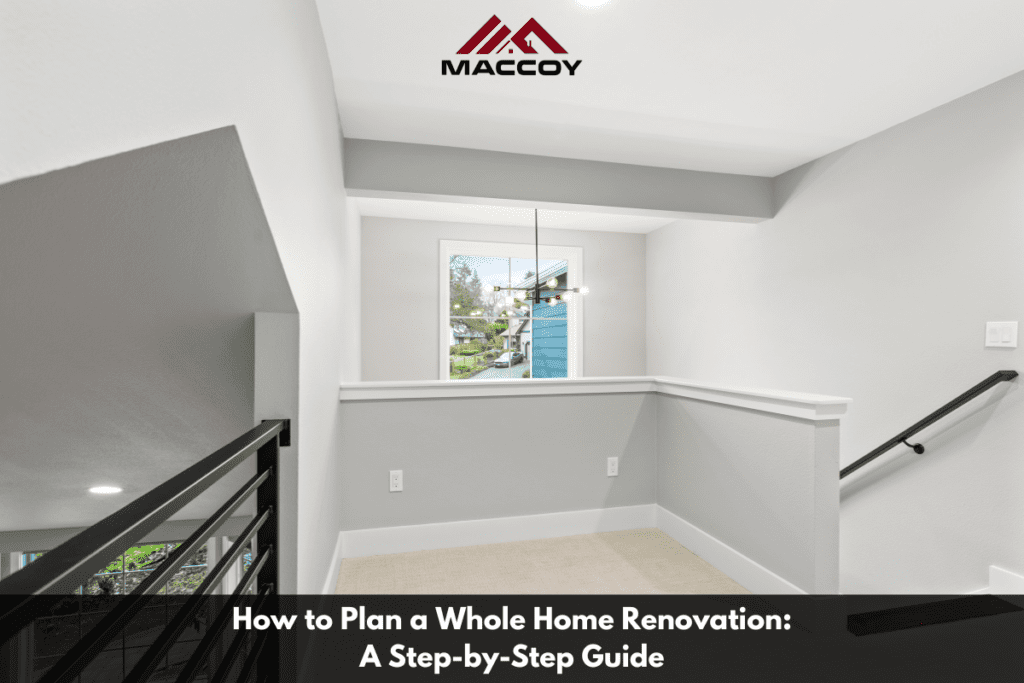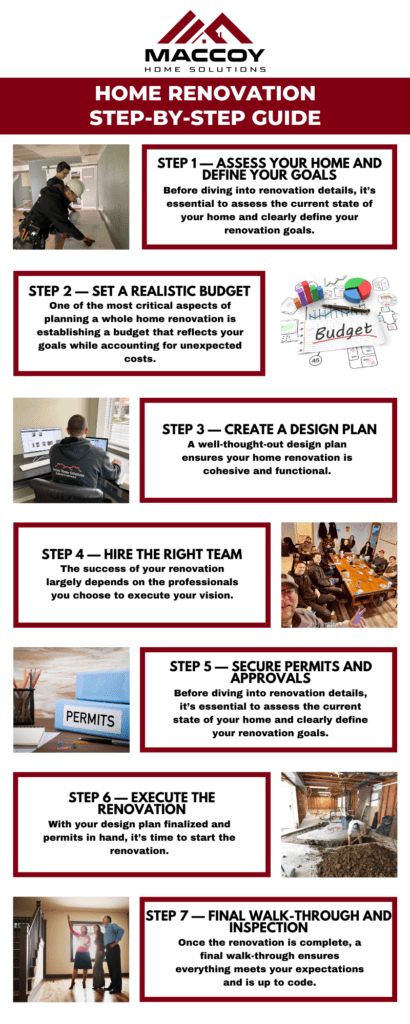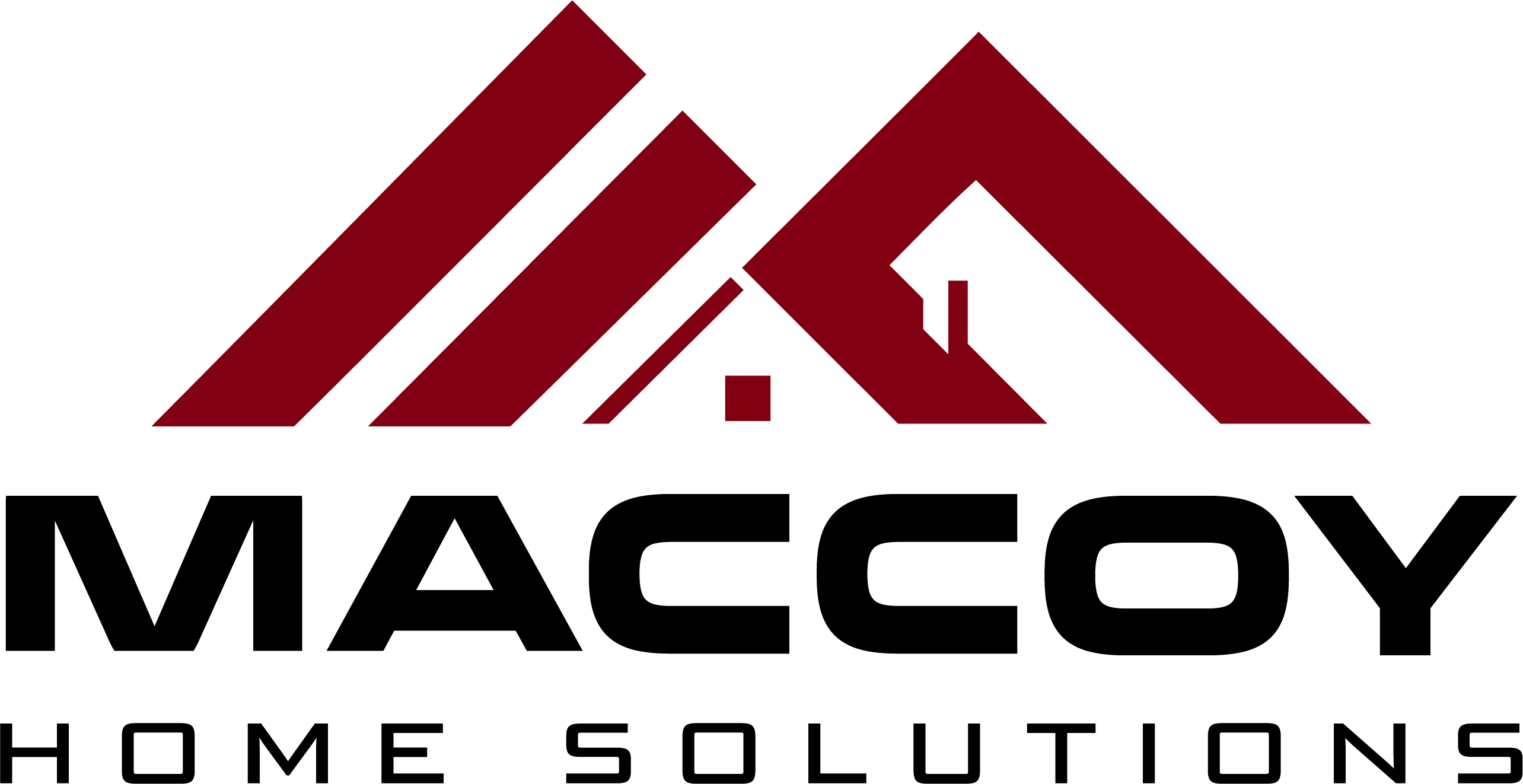
Planning a whole home renovation can seem overwhelming, but with proper preparation and organization, the process can be smooth and rewarding. A successful renovation requires thoughtful planning, realistic budgeting, and the right team to bring your vision to life. This step-by-step guide by MacCoy Home Solutions will help you plan a seamless renovation, from setting your goals to the final walk-through.

Step 1 —Assess Your Home and Define Your Goals
Before diving into renovation details, it’s essential to assess the current state of your home and clearly define your renovation goals. This step ensures you focus on improvements that add the most value and align with your lifestyle.
Questions to Consider:
- What areas of your home need the most attention?
- Are you looking for aesthetic upgrades, functional improvements, or both?
- Do you plan to live in the home long-term or sell it within a few years?
Tip: Make a list of “must-haves” versus “nice-to-haves” to prioritize key upgrades.
Example Goals:
- Expanding the kitchen to create an open-concept layout
- Upgrading bathrooms for a spa-like experience
- Improving energy efficiency with new windows, insulation, and HVAC systems
Step 2 — Set a Realistic Budget
One of the most critical aspects of planning a whole home renovation is establishing a budget that reflects your goals while accounting for unexpected costs.
How to Determine Your Budget:
- Assess Available Funds: Decide how much you’re willing to spend and whether you’ll use savings, a loan, or a home equity line of credit.
- Research Costs: Get a rough estimate of renovation costs for each area of the home.
- Costs for kitchen and bathroom remodels can vary widely based on design, materials, and scope. Contact us today for a free estimate tailored to your project needs!
- Include a Contingency: Allocate 10-20% of your budget for unexpected expenses, such as structural repairs or material delays.
Tip: Avoid over-improving beyond neighborhood standards, as it may limit your return on investment.
Step 3 — Create a Design Plan
A well-thought-out design plan ensures your home renovation is cohesive and functional. Work with a designer or architect to create a layout that maximizes space and complements your desired aesthetic.
Key Elements of a Design Plan:
- Floor Plan: Determine room layouts, wall removals, and extensions if needed.
- Material Selection: Choose flooring, countertops, fixtures, and cabinetry that align with your style and budget.
- Cohesive Style: Ensure consistency in color schemes, finishes, and materials across rooms to create a unified look.
Tip: Use mood boards or digital design tools to visualize the final result.
Internal Linking Opportunity: Consider linking to a service page for kitchen and bathroom upgrades for inspiration.
Step 4 — Hire the Right Team
The success of your renovation largely depends on the professionals you choose to execute your vision. Since MacCoy Home Solutions coordinates expert subcontractors, you can rely on us to manage every aspect of your project with precision.
Who You May Need:
- General contractor for overall project management
- Subcontractors for specialized work like electrical, plumbing, and flooring
- Interior designer or architect for design planning
How MacCoy Home Solutions Can Help:
- Seamless coordination of subcontractors
- Transparent communication throughout the project
- Detailed scheduling to keep your renovation on track
Tip: Verify licenses, read reviews, and ask for references before hiring any professional.
Step 5 — Secure Permits and Approvals
Most large-scale renovations require permits to ensure the work meets local building codes and regulations. At MacCoy Home Solutions, we assist with the permitting process to help ensure projects run smoothly and avoid potential delays or fines.
Common Permits Needed:
- Electrical, plumbing, and structural permits
- Additions or major alterations permits
- HVAC system upgrades
Tip: Work with your contractor to handle the permit application process. MacCoy Home Solutions ensures all required approvals are secured before starting construction.
Why Permits Matter:
- They ensure safety and structural integrity.
- They are essential for resale value, as homes without proper permits may face issues during inspection.
Step 6 — Execute the Renovation
With your design plan finalized and permits in hand, it’s time to start the renovation. During this phase, project management is key to staying on schedule and within budget.
What to Expect:
- Demolition: Removal of walls, fixtures, and materials no longer needed.
- Structural Work: Framing, plumbing, electrical, and HVAC installations.
- Finishing Touches: Flooring, cabinetry, painting, and fixture installation.
Tip: Maintain open communication with your contractor to address any concerns or changes promptly.
Avoid Common Pitfalls:
- Scope creep (adding extras that weren’t originally planned)
- Delays due to material shortages or unforeseen structural issues
Internal Linking Opportunity: Consider linking to a flooring installation service page if relevant.
Step 7 — Final Walk-Through and Inspection
Once the renovation is complete, a final walk-through ensures everything meets your expectations and is up to code. This step is crucial for identifying any areas that need touch-ups or adjustments.
Checklist for Final Inspection:
- Check for any unfinished work or defects.
- Ensure all electrical and plumbing fixtures are functional.
- Confirm that design elements match your original plan.
Tip: Don’t sign off on the project until you’re satisfied with the results.
FAQs
How long does a whole home renovation typically take?
The timeline for whole home renovations depends on the size of the home and the scope of the project. During our free estimation process, our team will provide you with a more accurate and personalized timeframe.
How do I know if I need a whole home renovation or just individual updates?
If multiple areas of your home require updates, and you’re seeking a cohesive design, a whole home renovation may be more cost-effective than individual updates.
What are some ways to stay on budget during a whole home renovation?
- Prioritize key areas like kitchens and bathrooms.
- Avoid making changes mid-project.
- Work with an experienced contractor who provides transparent cost estimates.
Conclusion
Planning a whole home renovation requires careful consideration, but with the right approach, it can be a life-changing investment. By following this step-by-step guide, you’ll be better prepared to manage the process, control costs, and achieve your dream home. Trust MacCoy Home Solutions to coordinate your renovation from start to finish, ensuring a seamless transformation that fits your vision and budget. Contact us today to get started!
